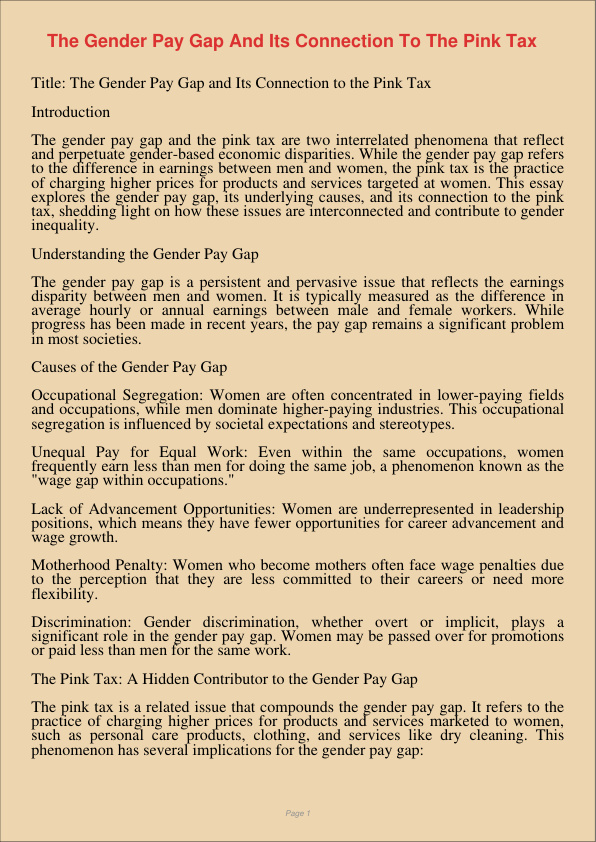The Gender Pay Gap And Its Connection To The Pink Tax
Dec 31, 2023
gender pay gap
pink tax
Law
Social science
Title: The Gender Pay Gap and Its Connection to the Pink Tax
Introduction
The gender pay gap and the pink tax are two interrelated phenomena that reflect and perpetuate gender-based economic disparities. While the gender pay gap refers to the difference in earnings between men and women, the pink tax is the practice of charging higher prices for products and services targeted at women. This essay explores the gender pay gap, its underlying causes, and its connection to the pink tax, shedding light on how these issues are interconnected and contribute to gender inequality.
Understanding the Gender Pay Gap
The gender pay gap is a persistent and pervasive issue that reflects the earnings disparity between men and women. It is typically measured as the difference in average hourly or annual earnings between male and female workers. While progress has been made in recent years, the pay gap remains a significant problem in most societies.
Causes of the Gender Pay Gap
Occupational Segregation: Women are often concentrated in lower-paying fields and occupations, while men dominate higher-paying industries. This occupational segregation is influenced by societal expectations and stereotypes.
Unequal Pay for Equal Work: Even within the same occupations, women frequently earn less than men for doing the same job, a phenomenon known as the “wage gap within occupations.”
Lack of Advancement Opportunities: Women are underrepresented in leadership positions, which means they have fewer opportunities for career advancement and wage growth.
Motherhood Penalty: Women who become mothers often face wage penalties due to the perception that they are less committed to their careers or need more flexibility.
Discrimination: Gender discrimination, whether overt or implicit, plays a significant role in the gender pay gap. Women may be passed over for promotions or paid less than men for the same work.
The Pink Tax: A Hidden Contributor to the Gender Pay Gap
The pink tax is a related issue that compounds the gender pay gap. It refers to the practice of charging higher prices for products and services marketed to women, such as personal care products, clothing, and services like dry cleaning. This phenomenon has several implications for the gender pay gap:
Economic Disparities: Women often pay more for products and services they need, which further stretches their limited financial resources.
Accumulated Impact: Over time, the extra expenses incurred due to the pink tax can result in substantial financial disparities, affecting women’s ability to save and invest, thus perpetuating the gender pay gap.
Gendered Marketing: Gendered marketing and pricing perpetuate traditional gender roles and stereotypes, reinforcing the notion that certain products are exclusively for women.
Consumer Choice Constraints: The pink tax limits women’s consumer choices, as they may be forced to pay more for products due to a lack of gender-neutral alternatives.
Combating the Gender Pay Gap and the Pink Tax
To address the gender pay gap and its connection to the pink tax, several measures can be taken:
Equal Pay Initiatives: Enforce equal pay legislation and promote pay transparency to close the gender pay gap within occupations.
Promote Gender-Neutral Pricing: Advocate for gender-neutral pricing policies that eliminate price disparities between products and services marketed to men and women.
Challenge Stereotypes: Raise awareness about the harmful impact of gendered marketing and work to dismantle gender stereotypes that contribute to both the pink tax and the gender pay gap.
Support Family-Friendly Policies: Implement family-friendly policies that support working parents and mitigate the motherhood penalty.
Promote Equal Representation: Encourage women’s participation in leadership positions across all industries to improve their earning potential and career advancement.
Conclusion
The gender pay gap and the pink tax are interconnected issues that perpetuate gender inequality in economic terms. Women continue to face unequal pay and bear the financial burden of discriminatory pricing. Recognizing the connection between these issues and taking action to eliminate them is essential for achieving economic gender equality. By addressing the gender pay gap and eliminating the pink tax, society can move closer to a future where all individuals, regardless of gender, are compensated fairly and have equal access to affordable products and services.
